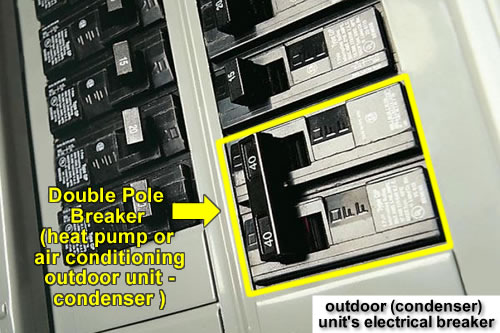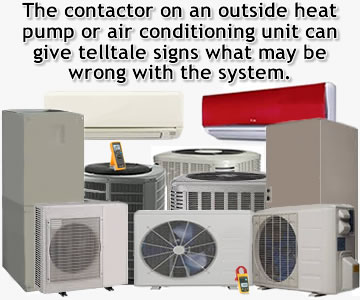If your heat pump or air conditioning system is not working properly, you can use this quick diagnosis to tell you what to look for to troubleshoot the problem.
What is a heat pump or air conditioning contactor?
An electrical contactor, used on most heat pump and air conditioning systems, is a component that allows high voltage to the condenser (outdoor unit) to operate. On most home HVAC systems, the switching of the contactor is controlled by a low-voltage current. When low voltage flows through the coil of the contactor, it draws in metal contacts (thus the name) to allow high-voltage electricity to flow through it. Under normal operation, this high-voltage current operates the condensing unit. To provide a simple comparison, imagine if you are low-voltage current and a light switch is the contactor. When the thermostat calls for the heat pump or air conditioning system to run, it tells you to switch on the light switch.
NOTE: This diagnosis will only on work on systems that worked properly before its current problem.
It is important that you follow these steps in order.
Turn off the electricity to the outdoor unit.
Go to your breaker (fuse) panel and turn OFF the electrical circuit breaker to the outdoor unit only. DO NOT turn off the electrical breaker to the indoor unit. This is an important step in diagnosing the system for problems. Typically, an outdoor condensing unit (heat pump or air conditioning) will be a double pole (two switch) breaker, and depending on its size, can be labeled between 15 - 60 amps on the breaker's housing or switch. DO NOT confuse it with the indoor unit which may also be a double pole or single pole (one switch) circuit breaker. To recap, the circuit breaker to the outdoor unit: OFF. The circuit breaker to the indoor unit: ON.
Important Note Before Continuing: Never ASSUME that by turning off an electric circuit breaker, or service disconnect or switch, or removing the fuses that the high-voltage power is shut off to the indoor or outdoor units! If you do not know how to check for high-voltage current at the indoor and outdoor units, this diagnosis is not something you should risk! Electric shock can cause serious injuries! DO NOT ATTEMPT!
Go to the thermostat that controls this system. At the thermostat turn the "COOL" switch to "ON" and the "FAN" switch to "AUTO." Turn the temperature setting down 10 degrees below the room's temperature.
WITH NO HIGH-VOLTAGE POWER TO THE OUTDOOR UNIT, remove the service panel, at the outdoor condensing unit, to inspect the contactor. Some contactors are double pole (two contacts) and some are single pole (one contact) (Refer to the illustration; r.734, above). Under normal operation, when the thermostat calls for the outdoor unit to run, it will send low-voltage electric current to magnetically draw in these contacts to provide high-voltage power to the condenser.
Some contactors have covers to protect them from insects and dirt. Removing this cover for inspection will not harm the operation of the contactor.
See the NOTE below before proceeding! Contactors can be in two positions: open or closed. If you can manually move the contacts on the contactor by pressing in on the plastic top; the contactor is open. If the contactor is closed, there will be no play between the contacts when you manually press on the plastic top of the contact.
NOTE: Manually pressing in on an open contact (WHEN THE HIGH-VOLTAGE POWER TO THE UNIT IS OFF!) will not damage the contactor.
Closed contacts are a sign of a high-voltage problem. It is telling you that the thermostat is calling for the condenser to run. All low-voltage current up to the contactor is correctly working.
Open contacts are a sign of a low-voltage problem. It is telling you that that something in the low-voltage circuit is open or defective. The problem could be in the thermostat, indoor or outdoor units.
NOTE: In the following steps you will be providing high-voltage electricity to the system. DO NOT move wires or put your hands in the outdoor unit or on any of its components, INCLUDING THE CONTACTOR CONTACTS. Because you removed the panel to the outdoor unit, all of its high-voltage connections are exposed. Make sure others are not accessible to the unit. This diagnosis is for visual inspection only! DO NOT try to move, or remove, wires and components while the power is on to the system! This could cause serious injuries!
Go back to the breaker panel and turn ON the circuit breaker to the outdoor condensing unit. This is where pinpointing the problem begins.
CHOOSE A STEP
If the indoor unit to this system is running and the outdoor unit's contactor is closed - Go to Step A.
If the indoor unit is running and the outdoor unit's contactor is open - Go to Step B.
If the indoor unit to this system is not running and the outdoor unit's contactor is closed - Go to Step C.
If the indoor unit is not running and the outdoor unit's contactor is open - Go to Step D.
Step A: The indoor unit is blowing air and the contactor is closed.
Step 1: Did the circuit breaker trip? If the electrical breaker did not trip, but stayed on, proceed to Step 2 below. You can tell that a circuit breaker has tripped because it cannot be immediately switched back to the "ON" position. It has to be reset by turning it to the "OFF" position then back to the "ON" position. If you turned on the electrical breaker and it tripped, do not turn the circuit breaker back on again! You have located your problem. There is a high-voltage short in a wire or an electrical component in the outdoor condensing unit.
High-voltage components in the outdoor unit include:
A: the compressor
B: the outdoor fan motor
C: capacitors
D: circuit boards, defrost controls, or relays
The other problem that could be wrong with the system, using this Step 1 scenario, is a shorted high-voltage wire. Somewhere in the high-voltage wiring from the breaker panel up to or in the outdoor unit is a wire that is shorting causing the circuit breaker to trip. This could be from cut, damaged, or decayed high-voltage wires. Also, look for loose connections at terminals or in wire nuts.
Proceed to Step E.
Step 2: Did the circuit breaker stay on? If you turned on the electrical breaker to the condensing unit and it stayed on (did not trip), proceed to the outdoor unit. Is the unit running? If the unit is not running, and the contactor is CLOSED, proceed to Step 3 below. If the unit is running, there is a problem within the system that is keeping it from cooling properly. Listed here, in priority order, could be potential problems with the system.
A: Dirty indoor air filter and/or indoor coil.
B: Low refrigerant pressures. Leak in system. This includes contaminated refrigerant (dirt, moisture, mixed, noncondensibles).
C: Component(s) not working properly. This includes indoor and outdoor fan motors, compressor, circuit boards, relays, capacitors, contactor, TXV (Thermal Expansion Valve), and reversing valve. Reversing valves are only located on heat pumps.
D: Dirty outdoor condensing coil.
E: Improper electrical current (amperage) to system. This includes worn high-voltage wires, bad connections, defective electrical circuit breaker, or fuses.
Proceed to Step E.
Step 3: If the electrical breaker did not trip when you turned it on, but the outdoor unit is not running and the contactor is CLOSED, the outdoor unit is not getting high-voltage power to the unit. Listed here, in priority order, could be potential problems with the system.
A: Improper electrical current (amperage) to unit. This includes cut, damaged, or decayed wires, defective circuit breaker, or fuses.
B: Outdoor service disconnect. Blown fuses, bad electrical connections, worn out switch or service disconnect.
C: Electric contactor is not allowing proper electrical current to system. This includes worn out contact(s) or contact(s) not seating properly because of dirt/insects in between contact(s), or bad electrical connections where high-voltage wires enter and exit the contactor.
Proceed to Step E.
Step B: The indoor unit is running and the contactor is open.
Step 1: If the electrical breaker did not trip when you turned it on, and the indoor unit is running, but the outdoor unit's contactor is OPEN, there is a low-voltage problem to the contactor. This problem may be caused by (in priority order):
A: Defective or open low-voltage component in the condensing unit. This includes, sensors, limits, circuit boards, and relays.
B: The low-voltage wiring in the condenser is cut, broken, decayed, or has bad connections (terminals, wire nuts).
C: The low-voltage wiring from the indoor unit to the contactor is cut, damaged, decayed, or has bad connections at terminals or in wire nuts.
D: Defective thermostat or low voltage wiring from the thermostat to the condenser is cut, damaged, decayed, or has bad connections at terminals or in wire nuts.
Proceed to Step E.
Step C: The indoor unit is not blowing air and the contactor is closed.
If the indoor unit (air handler or furnace) is not operating and the condensing unit's contactor is CLOSED, there is a problem with the indoor unit's blower assembly (motor and wheel). Low-voltage current, for the entire heat pump or air conditioning system, is supplied by the indoor unit's electrical step-down transformer (component that transforms high voltage to low-voltage current), and the outdoor unit needs low-voltage current to close its contacts.
A circuit board or relay that controls the indoor blower will not transfer low-voltage power to the outdoor condensing unit if there is a problem with a low-voltage component in the indoor unit. The contactors being closed in this Step C scenario is showing us that there is a high-voltage problem or defective component in the indoor unit. Here are the components that may need to be serviced (in priority order).
A: Defective motor capacitor
B: Defective blower (fan) motor
C: High-voltage wires: cut, damaged, loose connections at terminals or wire nuts.
D: Blower wheel is damaged, set screw has loosened, wheel is locked against blower housing.
Proceed to Step E.
Step D: The indoor unit is not running and the contactor is open.
If the indoor air handler (blower) or furnace fan is not running, the outdoor condensing unit's contactor can tell you if it is a high-voltage or low-voltage problem.
Step 1: If the indoor unit is not running and the outdoor condenser's contactor is OPEN, the indoor unit or thermostat is not supplying low-voltage power to operate the entire system. Go to the breaker panel and check that the indoor unit's circuit breaker is ON. Make sure the service switch near the indoor unit is turned ON. Go to your thermostat. Turn the "COOL" switch to "OFF" and the "FAN" switch to "ON". Did the indoor unit start? If the indoor unit did not start, you have a problem with the indoor unit. Listed here in priority order are items to troubleshoot.
A: Defective voltage step-down transformer.
B: Defective indoor blower (fan) motor.
C: Defective circuit board, relay, or sensor. Check for any blown fuses on the circuit board.
D: Defective thermostat.
E: Improper high-voltage current to indoor unit. This can be caused by cut, broken, or decayed, high-voltage wires. Look for bad connections (terminals and wire nuts), defective circuit breaker, or service switch.
*F: Improper low-voltage current from voltage transformer to thermostat to indoor unit's fan relay or circuit board.
*Some indoor units (especially furnaces) have several low-voltage sensors and limits that are wired in series with low-voltage components. An OPEN sensor/limit will interrupt all low-voltage functions.
Proceed to the next step.
Step E: If you never serviced an HVAC system, do not start now.
Now that you have located this problem, you will need to get an experienced HVAC technician to troubleshoot the system. If you do not know the principles of electricity, compression, absorption, and heat transfer (just to name few), it is dangerous to proceed further. If you do not know how to properly read an electrical multimeter, refrigerant pressures and their relationship to temperatures, you need to stop here and call in experienced help.
Push the electrical breakers to the "OFF" position, replace the screws and cover on the contactor (if supplied), and replace the outdoor condensing unit's service panel.
You have a starting point of locating the problem with your heat pump or air conditioning system. This alone will save you time (and even money) by telling a service technician what you have found.






